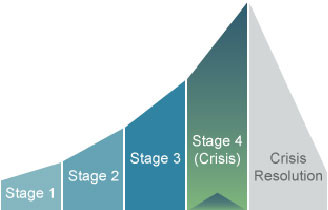Four Levels of Crisis Development Behavior Levels
The CPI Crisis Development Model Behavior Levels Staff Attitudes 1. A Crisis Can Develop Spiritual Renewal.
Crisis Development Behavior Levels At Level
Supportive An empathic nonjudgmental approach attempting to alleviate anxiety.

. Crisis self and observers Isolate student by removing the audience Call for help staff witness if needed Dont threaten consequences now. Anxiety is defined as a change in behavior and our first chance to look at things differently. Redirect back to topic avoid power struggle b.
Erikson maintained that personality develops in a predetermined order through eight stages of psychosocial development from infancy to adulthood. While they vent you breathe deeply and slowly. Trusting that behavior impacts behavior there is always potential for a positive outcome in the four levels of the Crisis Development Model.
A Support Network Can Grow During a Crisis. The first stage of Eriksons theory of psychosocial development occurs between birth and 1 year of age and is the most fundamental stage in life. Your role here is to provide.
While public relations is commonly known for its unethical conduct unethical behaviors should be understood at three levels. The supportive approach requires the staff to be empathic and actively listen to what is bothering the individual. CPIs Crisis Development Model.
Listen so as to encourage problem solving. Crisis Development Behavior Levels 1. What are the four levels of crisis development.
What are the best practice for new product development projects. Nonviolent Physical Crisis InterventionSM 4. Anxiety is defined as a change in behavior and our first chance to look at things differently.
Tension Reduction Staff AttitudesApproaches 1. Core Values Can Be Clarified When a Crisis Takes Place. There are four approaches in the development of moral behavior the psychoanalytic approach the social-group approach the learning-theory approach and the cognitive developmental approach.
Pacing finger drumming wringing of the hands or staring. Regaining of rationality 4. If anxiety is not diffused defensive behavior typically follows.
Discuss when the student is more rational De-Escalation Having vented the severity of students behavior subsides Drop in energy level of student after a crisis. Acting-Out Person AOP 4. An approach used to re-establish communication with an individual who is experiencing.
What is a characteristic of Visual. What is the present value if an organization expects to make 100000 four years from now and the annual interest rate is 6 percent. Pacing finger drumming wringing of hands starring.
During each stage the person experiences a psychosocial crisis which could have a positive or negative outcome for personality development. The Crisis Development Modeld Crisis developmentbehaviour levels Staff attitudesApproaches Anxiety Defensive Acting out person Therapeutic rapport Supportive Directive Nonviolent physical crisis intervention Tension reduction 1. It may be tempting to ignore mitigation and preparedness when youre in the middle of a crisis and move right to response and recovery modes.
Individuals at this. For Erikson 1958 1963 these crises are of a. A Clear Sense of Direction Can Be Produced Through a Crisis.
Challenging questioning authority 2. Answer question set limits ifexcessive students stalling tactic b. Non Violent Crisis Prevention 1.
Which term is used to considers the total cost of ownership or develpment plus support costs for a project. Behavior Levels Crisis Development Staff Attitude Anxiety A noticeable increase or change in behavior eg. Individual organizational and national.
A noticeable increase or change in behavior that is manifested by a non-directed expenditure of energy. The Eight Stages of Development created by Erik Erikson 1956 is a widely used and universally accepted model explaining the developmental tasks involved in the social and emotional development of children that continues into adulthood. Or a non-directed expenditure of energy eg.
However there are four behaviors that can be learned during a crisis. At this level in a crisis individuals are exhibiting a change in their behavior. There are four phases of crisis management that can help keep a focus on the institutions long-term mission and goals.
What are the levels of crisis developmentbehavior levels in the Crisis Development Model. The care welfare safety and security of others 2. An Opportunity for a Positive Outcome Anxiety.
Four Phases of Crisis Management. Refusal Set limits give clear and limited choices avoid jargon use enforceable consequences - 3. CPI Development Model Crisis DevelopmentBehavior 1.
What are the staff attitudesapproaches in the Crisis Development Model. Allow the angry person to vent onl y at this stage. Most people do not want to deal with intense events produced by any crisis.
Be self-assured not arrogant. 2 Each developmental stage includes a major crisis that the. Levels of Crisis Intervention Level I.
What are the four levels of crisis development. Tension-Reduction Decrease in physical and emotional energy which occurs after a person has acted out characterized by the regaining of rationality. Because an infant is utterly dependent developing trust is based on the dependability and quality of the childs caregivers.
Info seeking reasonable rational a. Anxiety def A change in behavior. Trigger Stage At this level allow the angry person some control yet maintain total control of conversation and its direction.
The question of ethical behaviour from the level of the individual through the totality of organizational manifestations to the level of national and international bodies has become the number one issue on the global.

Crisis Development Behavior Levels At Level

Comments
Post a Comment